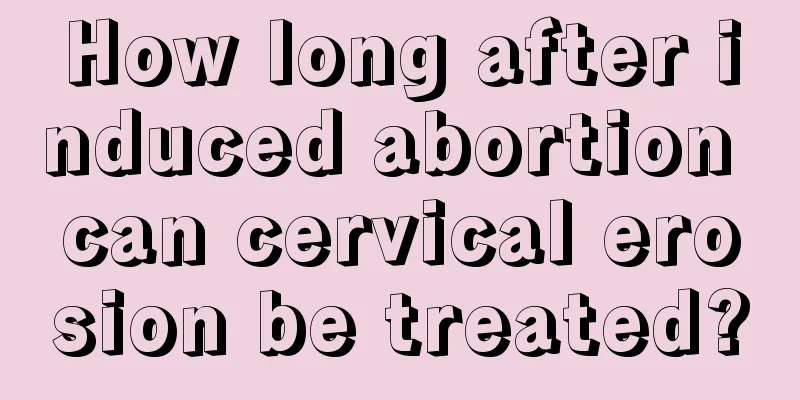How long after induced abortion can cervical erosion be treated?

|
Pregnancy is the happiest thing for every married woman, but some fetuses may have physical disabilities due to genetic or developmental problems. In this case, doctors will recommend women to terminate the pregnancy. When the fetus is older, the only solution is induced abortion. Some women suffer from gynecological diseases such as cervical erosion. So how long after induced abortion can the cervical erosion be treated? Here are several methods of treating cervical erosion for you to learn about. 1. What to do if you have cervical erosion 1. Medication For mild patients, since the inflammation is not serious, drug treatment is generally sufficient. Use antibiotics and antiviral drugs to wipe the affected area. You can also cooperate with traditional Chinese medicine treatment. Grind the formula into powder, dip it with a cotton ball, and apply it to the affected area. You need to actively cooperate with the doctor's instructions for better and more significant results. 2. Physical therapy For moderate and severe patients, freezing and laser can be used to damage the columnar epithelium at the erosion site, killing it and causing it to gradually fall off, allowing new cervical squamous epithelium to grow. This method takes less time and has better effects, and is the most widely used treatment method. However, this method may affect the quality of intimacy between the couple because it will damage the nerve sensitivity of the vaginal wall, and there is also a risk of recurrence. 3. Surgery Surgical treatment is relatively traditional and is mainly aimed at severe patients whose affected area is large. In addition, if they are affected by inflammation and cervical polyps or cervical hypertrophy occur, surgical treatment is required for removal. However, due to its high cost, heavy bleeding, and many damages, it is not recommended and is rarely used at present. 4. Diet (1) Eat more refreshing and delicious food, and eat more vegetables and fruits rich in vitamins and proteins, such as cucumbers, tofu, chicken, crucian carp, apples, bananas, etc. (2) Avoid eating spicy or irritating foods, such as chili peppers, leeks, white wine, onions, etc. These foods will irritate the female body, causing further congestion in the pelvic cavity, or causing excessive tightening of the uterine muscles, leading to increased inflammation and expansion of the area of erosion. (3) Eat less blood-clotting foods and foods containing hormones. Do not assume that these foods are good for women’s physiological regulation. In fact, for women with this symptom, they will have the opposite effect. For example, donkey-hide gelatin, which many women love to eat, as well as red dates and longans, should not be eaten too much. 5. Daily care In addition to some professional treatments, daily care is also very important. (1) Keep your private parts clean and hygienic This does not mean that you should use more disinfectant to clean the vagina, which will only destroy the normal environment of the vagina. Just use clean warm water to perform necessary cleaning on the vulva. (2) Take safety measures If you and your partner do not want a baby in the near future, please take safety measures, reduce artificial abortions, prevent the cervix from being damaged by human factors, and make it difficult for germs to enter the body. At the same time, pregnant women also need to pay more attention to delivery instruments to prevent these instruments from damaging the cervix. (3) Intimate behavior should be properly controlled During treatment, women should abstain from sexual intercourse until the damage has been repaired. After recovery, the frequency of sexual intercourse should be reduced, as excessive sexual activity will cause the disease to relapse. In addition, hygiene in intimate behavior should be maintained. Women are strictly prohibited from being intimate with their partners during menstruation, so as to ensure the health of the cervix. (4) Carry out regular gynecological examinations After recovery, regular check-ups are also needed to prevent recurrence of the disease. 6. Other treatments In addition to the above five treatment methods, there are now high-tech treatment methods. Such surgeries as BBT ablation and high-frequency LEEP are more delicate, less painful, can effectively avoid complications, and have fewer side effects, but they are relatively expensive. |
<<: The latest childbearing age for women
>>: Is laser treatment good for cervical erosion?
Recommend
Is the belly noticeable when pregnant for three months?
Three months of pregnancy is considered a dividin...
How many centimeters should the cervix be dilated to give birth?
Pregnancy and childbirth are situations that all ...
Why does the sole of a pregnant woman hurt?
Many people often feel pain in the soles of their...
Learn about tumor markers
Author: Li Shengmin, Zhongshan Hospital Affiliate...
Can I eat whole wheat bread while breastfeeding?
You can eat whole wheat toast appropriately durin...
Uncovering the shocking curriculum of the Spanish prostitute school
According to Spanish media reports, a "prost...
What to eat to increase progesterone levels
For pregnant women, progesterone level is an impo...
What is the normal value of progesterone after pregnancy?
After pregnancy, the growth hormone in women'...
What to do if you have pregnancy spots on your face
Stretch marks are something that female friends a...
Is there any cure for obsessive-compulsive disorder? If you are going crazy, you must read this cartoon!
Every day I have to check if I have locked the do...
How to prevent junctional mucinous ovarian cysts
Ovarian cysts are a very common disease in women....
What is the difference between 28 weeks of pregnancy and 28 weeks of pregnancy?
Once a woman becomes pregnant, her body becomes v...
What can't you eat if you have cervical erosion? Don't touch these
When it comes to cervical erosion, everyone may b...
What to eat to recover quickly from ovarian hyperactivity
Ovarian overactivity is a type of female reproduc...
Do you need to add white wine to pickle sugar garlic? Why do you need to add white wine to pickle sugar garlic?
We all know that garlic is a common ingredient. I...









